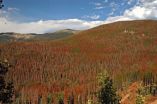(Press-News.org) Combine the tree-ring growth record with historical information, climate records, and computer-model projections of future climate trends, and you get a grim picture for the future of trees in the southwestern United States. That's the word from a team of scientists from Los Alamos National Laboratory, the U.S. Geological Survey, the University of Arizona, and other partner organizations.
If the Southwest is warmer and drier in the near future, widespread tree death is likely and would cause substantial changes in the distribution of forests and of species, the researchers report this week in the journal Nature Climate Change.
Southwestern forests grow best when total winter precipitation is high combined with a summer and fall that aren't too hot and dry.
The team developed a Forest Drought-Stress Severity Index that combines the amount of winter precipitation, late summer and fall temperatures, and late summer and fall precipitation into one number.
"The new 'Forest Drought-Stress Index' that Williams devised from seasonal precipitation and temperature-related variables matches the records of changing forest conditions in the Southwest remarkably well," said co-author Thomas W. Swetnam, director of the UA Laboratory of Tree-Ring Research.
"Among all climate variables affecting trees and forests that have ever been studied, this new drought index has the strongest correlation with combined tree growth, tree death from drought and insects, and area burned by forest fires that I have ever seen."
A. Park Williams of Los Alamos National Laboratory in New Mexico is the lead author of the paper, "Temperature as a potent driver of regional forest drought stress and tree mortality." Six of the paper's 15 authors are at the UA. A complete list of authors is at the bottom of this release.
To figure out which climate variables affect forests, the researchers aligned some 13,000 tree core samples with known temperature and moisture data. The team also blended in events known from tree-ring, archaeological and other paleorecords, such as the late 1200s megadrought that drove the ancient Pueblo Indians out of longtime settlements such as those at Mesa Verde, Colo.
By comparing the tree-ring record to climate data collected in the Southwest since the late 1800s, the scientists identified two climate variables that estimate annual southwestern tree-growth variability with exceptional accuracy: total winter precipitation and average summer-fall atmospheric evaporative demand, a measure of the overall dryness of the environment.
Williams said, "Atmospheric evaporative demand is primarily driven by temperature. When air is warmer, it can hold more water vapor, thus increasing the pace at which soil and plants dry out. The air literally sucks the moisture out of the soil and plants."
Finding that summer-fall atmospheric evaporative demand is just as important as winter precipitation has critical implications for the future of southwestern forests, he said.
These trends, the researchers noted, are already occurring in the Southwest, where temperatures generally have been increasing for the past century and are expected to continue to do so because of accumulating greenhouse gases in the atmosphere.
There still will be wet winters, but increased frequency of warmer summers will put more stress on trees and limit their growth after wet winters, the study reports.
"We can use the past to learn about the future," Williams said. "For example, satellite fire data from the past 30 years show that there has been a strong and exponential relationship between the regional tree-ring drought-stress record and the area of southwestern forests killed by wildfire each year. This suggests that if drought intensifies, we can expect forests not only to grow more slowly, but also to die more quickly."
The study points out that very large and severe wildfires, bark-beetle outbreaks and a doubling of the proportion of dead trees in response to early 21st-century warmth and drought conditions are evidence that a transition of southwestern forest landscapes toward more open and drought-tolerant ecosystems may already be underway.
And while 2000s drought conditions have been severe, the regional tree-ring record indicates there have been substantially stronger megadrought events during the past 1,000 years.
The strongest megadrought occurred during the second half of the 1200s and is believed to have played an important role in the abandonment of ancient Puebloan cultural centers throughout the Southwest. The most recent megadrought occurred in the late 1500s and appears to have been strong enough to kill many trees in the Southwest.
"When we look at our tree-ring record, we see this huge dip in the 1580s when all the tree rings are really tiny," Williams said. "Following the 1500s megadrought, tree rings get wider, and there was a major boom in new trees. Nearly all trees we see in the Southwest today were established after the late-1500s drought, even though the species we evaluated can easily live longer than 400 years. So that event is a benchmark for us today. If forest drought stress exceeds late 1500 levels, we expect that a lot of trees are going to be dying."
Will future forest drought-stress levels reach or exceed those of the megadroughts of the 1200s and 1500s?
Using climate-model projections, the team projected that such megadrought-type forest drought-stress conditions will be exceeded regularly by the 2050s. If climate-model projections are correct, forest drought-stress levels during even the wettest and coolest years of the late 21st century will be more severe than the driest, warmest years of the previous megadroughts.
The study forecasts that during the second half of this century, about 80 percent of years will exceed megadrought levels.
The current drought, which began in 2000, is a natural case study about what to expect from projected climate scenarios. While average winter precipitation totals in the Southwest have not been exceptionally low, average summer-fall evaporative demand is the highest on record.
And trees, Williams says, are paying the price. The team concluded forest drought stress during more than 30 percent of the past 13 years, including 2011 and 2012, matched or exceeded the megadrought-type levels of the 1200s and 1500s. The only other 13-year periods when megadrought-type conditions were reached with such frequencies in the past 1,000 years were during the megadroughts themselves.
UA co-author Daniel Griffin said, "This research is distinctly different from work done in a similar vein in two ways: One, it puts these projections for the future in a concrete historical context, and two, it shows that the impacts on the forests will not be restricted to one species or one site at low elevation, but in fact will take place at forests across the landscape."
Griffin is a doctoral candidate in the UA School of Geography and Development.
Co-author Craig D. Allen, a research ecologist with the U.S. Geological Survey, said, "Consistent with many other recent studies, these findings provide compelling additional evidence of emerging global risks of amplified drought-induced tree mortality and extensive forest die-off as the planet warms."
The article, "Temperature as a potent driver of regional forest drought stress and tree mortality," is written by A. Park Williams (Los Alamos National Laboratory), Craig D. Allen (U.S. Geological Survey), Alison K. Macalady (University of Arizona), Daniel Griffin (UA), Connie A. Woodhouse (UA), David M. Meko (UA), Thomas W. Swetnam (UA), Sara A. Rauscher (LANL), Richard Seager (Columbia Univ.), Henri D. Grissino-Mayer (Univ. of Tennessee), Jeffrey S. Dean (UA), Edward R. Cook (Columbia Univ.), Chandana Gangodagamage (LANL), Michael Cai (LANL) and Nate G. McDowell (LANL).
Los Alamos National Laboratory, the U.S. Department of Energy, and the National Science Foundation funded the research.
INFORMATION:
Scientist contacts:
Connie Woodhouse, 520-626-0235, conniew1@email.arizona.edu
Thomas W. Swetnam, 520-621-2112, tswetnam@ltrr.arizona.edu
Daniel Griffin, dgriffin@email.arizona.edu
Craig Allen, 505-672-3861 ext. 720, craig_allen@usgs.gov
For Park Williams: LANL PIO: Nancy Ambrosiano, 505-667-0471, nwa@lanl.gov
Media contacts:
Nancy Ambrosiano, LANL 505-667-0471, nwa@lanl.gov
Catherine Puckett, USGS 352-377-2469, cpuckett@usgs.gov
Heidi Koontz, USGS 303-202-4763, hkoontz@usgs.gov
Daniel Stolte, UA 520-626-4402, stolte@email.arizona.edu
Mari N. Jensen, 520-626-9635, mnjensen@email.arizona.edu
Climate change could cripple southwestern forests
Trees face rising drought stress and mortality as climate warms
2012-10-01
ELSE PRESS RELEASES FROM THIS DATE:
Common RNA pathway found in ALS and dementia
2012-10-01
Two proteins previously found to contribute to ALS, also known as Lou Gehrig's disease, have divergent roles. But a new study, led by researchers at the Department of Cellular and Molecular Medicine at the University of California, San Diego School of Medicine, shows that a common pathway links them.
The discovery reveals a small set of target genes that could be used to measure the health of motor neurons, and provides a useful tool for development of new pharmaceuticals to treat the devastating disorder, which currently has no treatment or cure.
Funded in part by ...
The genetics of white finger disease
2012-10-01
Vibration-induced white finger disease (VWF) is caused by continued use of vibrating hand held machinery (high frequency vibration >50 Hz), and affects tens of thousands of people. New research published in BioMed Central's open access journal Clinical Epigenetics finds that people with a genetic polymorphism (A2191G) in sirtuin1 (SIRT1), a protein involved in the regulation of endothelial NOS (eNOS), are more likely to suffer from vibration-induced white finger disease.
VWF (also known as hand arm vibration syndrome (HAVS)) is a secondary form of Raynaud's disease involving ...
Breast cancer recurrence defined by hormone receptor status
2012-10-01
Human epidermal growth factor (HER2) positive breast cancers are often treated with the same therapy regardless of hormone receptor status. New research published in BioMed Central's open access journal Breast Cancer Research shows that women whose HER2 positive cancer was also hormone (estrogen and progesterone) receptor (HR) negative had an increased risk of early death, and that their cancer was less likely to recur in bone than those whose cancer retained hormone sensitivity.
Breast cancer is a heterogeneous disease with many different subtypes. HR positive cancer ...
Scientists find missing link between players in the epigenetic code
2012-10-01
CHAPEL HILL, N.C. – Over the last two decades, scientists have come to understand that the genetic code held within DNA represents only part of the blueprint of life. The rest comes from specific patterns of chemical tags that overlay the DNA structure, determining how tightly the DNA is packaged and how accessible certain genes are to be switched on or off.
As researchers have uncovered more and more of these "epigenetic" tags, they have begun to wonder how they are all connected. Now, research from the University of North Carolina School of Medicine has established ...
Blocking key protein could halt age-related decline in immune system, Stanford study finds
2012-10-01
STANFORD, Calif. — The older we get, the weaker our immune systems tend to become, leaving us vulnerable to infectious diseases and cancer and eroding our ability to benefit from vaccination. Now Stanford University School of Medicine scientists have found that blocking the action of a single protein whose levels in our immune cells creep steadily upward with age can restore those cells' response to a vaccine.
This discovery holds important long-term therapeutic ramifications, said Jorg Goronzy, MD, PhD, professor of rheumatology and immunology and the senior author of ...
Noninvasive measurement enables use of IFP as potential biomarker for tumor aggressiveness
2012-10-01
PHILADELPHIA — Researchers validated a method of noninvasive imaging that provides valuable information about interstitial fluid pressure of solid tumors and may aid in the identification of aggressive tumors, according to the results of a study published in Cancer Research, a journal of the American Association for Cancer Research.
Many malignant solid tumors generally develop a higher interstitial fluid pressure (IFP) than normal tissue. High IFP in tumors may cause a reduced uptake of chemotherapeutic agents and resistance to radiation therapy. In addition, a high ...
Mayo Clinic physicians ID reasons for high cost of cancer drugs, prescribe solutions
2012-10-01
ROCHESTER, Minn. -- A virtual monopoly held by some drug manufacturers in part because of the way treatment protocols work is among the reasons cancer drugs cost so much in the United States, according to a commentary by two Mayo Clinic physicians in the October issue of the journal Mayo Clinic Proceedings. Value-based pricing is one potential solution, they write.
VIDEO ALERT: Video of Dr. Rajkumar discussing the commentary is posted on the Mayo Clinic News Network.
Cancer care is not representative of a free-market system, and the traditional checks and balances that ...
Republican strength in congress aids super-rich, president's affiliation has no effect
2012-10-01
WASHINGTON, DC, September 27, 2012 — Republican strength in Congress increases the share of income held by the top 1 percent, but the president's political affiliation has no effect, suggests a new study in the October issue of the American Sociological Review that looks at the rise of the super-rich in the United States.
"This points to the central role that Congress has in the legislative process," said study co-author Thomas W. Volscho, an Assistant Professor of Sociology at CUNY-College of Staten Island. "The president has limited ability to make the sort of legislative ...
Patient-led advocacy has changed how US government funds medical research
2012-10-01
WASHINGTON, DC, September 27, 2012 — Patient-led advocacy has created a shift in the way the U.S. government has prioritized funding for medical research, and significantly changed the way policymakers think about who benefits the most from these dollars, a University of Michigan School of Public Health fellow in the Robert Wood Johnson Foundation Scholars in Health Policy Research Program found.
In "Disease Politics and Medical Research Funding: Three Ways Advocacy Shapes Policy," a paper published in the October issue of the American Sociological Review, Rachel Kahn ...
End your child's allergy suffering within 3 years
2012-10-01
ARLINGTON HEIGHTS, Ill. (October 1, 2012) – When children suffer from dust mite induced allergies and asthma, finding relief can seem impossible. While there isn't a complete cure for childhood respiratory allergies, researchers have found that long term control of allergic asthma can occur after only three years of allergy shots.
According to a new study, published in the October issue of Annals of Allergy, Asthma and Immunology, the scientific publication of the American College of Allergy, Asthma and Immunology (ACAAI), long-term relief can be achieved by administering ...
LAST 30 PRESS RELEASES:
Making simulations more accurate than ever with deep learning
Better predicting the lifespan of clean energy equipment, towards a more efficient design
Five ways microplastics may harm your brain
Antibody halts triple-negative breast cancer in preclinical models
Planned birth at term reduces pre-eclampsia in those at high risk
Penguins starved to death en masse, study warns, as some populations off South Africa estimated to have fallen 95% in just eight years
New research explains how our brains store and change memories
Space shuttle lessons: Backtracks can create breakthroughs
New study finds cystic fibrosis drug allows patients to safely scale back lung therapies
From field to lab: Rice study reveals how people with vision loss judge approaching vehicles
Study highlights underrecognized link between kidney disease and cognitive decline
Researchers find link between psychosocial stress and early signs of heart inflammation in women
Research spotlight: How long-acting injectable treatment could transform care for postpartum women with HIV
Preempting a flesh-eating fly’s return to California
Software platform helps users find the best hearing protection
Clean hydrogen breakthrough: Chemical lopping technology with Dr. Muhammad Aziz (full webinar)
Understanding emerges: MBL scientists visualize the creation of condensates
Discovery could give investigators a new tool in death investigations
Ultrasonic pest control to protect beehives
PFAS mixture disrupts normal placental development which is important for a healthy pregnancy
How sound moves on Mars
Increasing plant diversity in agricultural grasslands boosts yields, reducing reliance on fertilizer
Scientists uncover a new role for DNA loops in repairing genetic damage
AI chatbots can effectively sway voters – in either direction
Study reveals 'levers' driving the political persuasiveness of AI chatbots
'Tiny' tyrannosaurid, Nanotyrannus lancensis, was a distinctive species, not juvenile T. Rex
Scientists capture first detailed look inside droplet-like structures of compacted DNA
Return of the short (tyrant) king: A new paper by Dinosaur Institute researcher shows Nanotyrannus was not a juvenile T. Rex
New study confirms Nanotyrannus holotype was distinct species from T. rex
Carnegie Science names Michael Blanton 12th Observatories Director
[Press-News.org] Climate change could cripple southwestern forestsTrees face rising drought stress and mortality as climate warms


